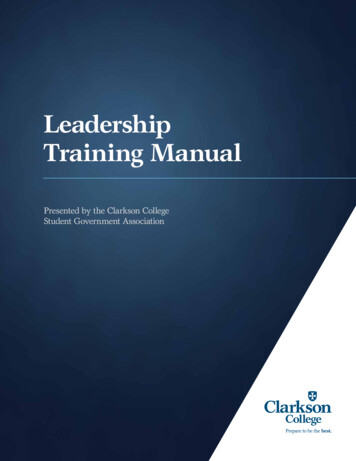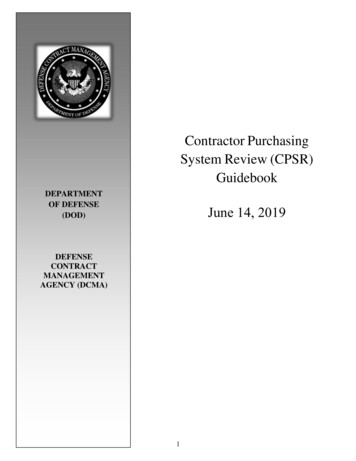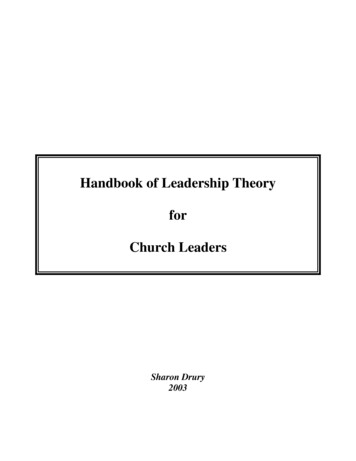
Transcription
LEADERSHIPDEVELOPMENTGUIDEBOOKFOR TEENAGE YOUTH
Leadership DevelopmentGuidebook forTeenage Youth
32148ISBN 978-0-8395-2148-8 2006 Learning for Life2019 Printing
CONTENTSOverview.1Instructional Objectives.1List of Leadership Development WorkshopLesson Plans.1Leadership Development Workshop SeriesLesson Plans.13Introduction to Leadership.15Time Management.31Sample Schedules for Workshops.1Meeting Management.57One-Day Workshop Sample Schedule.2Communication.77Overnight Workshop Sample Schedule.4Decision Making.99Multiday Workshop Sample Schedule.6Goal Setting.109Budgeting.7Team Building.125Site Selection.7Effective Group Management.139Workshop Instructors.7Motivation.157Motivational Speaker.7Managing Through Others/Delegating.167Training Aids and Equipment Required.7Analysis/Evaluation.175Publicizing the Workshops.8Beliefs and Values.187Recognition.8Diversity, Culture, and Climate.199Backdating.8Character of Leadership.205Sample Leadership DevelopmentWorkshop Series Announcement.9Ethics of Leadership.215Leadership Development Workshop SeriesSample Registration Form.10Icebreakers.11Leadership Development WorkshopSeries Recognition Certificate.12Planning—Sequence of Events.223Workshop Reference Materials.235
OVERVIEWThe Leadership Development Workshop Series isfor Learning for Life senior high school groups,work-based Explorer posts, and any other programs serving teenage youth. The LeadershipDevelopment Workshop Series lesson plans provide high school students with exposure to lifeskills, personal management skills, and groupleadership skills. Students learn to apply theseskills in real-life leadership situations.The Workshop Series can be offered as aone-day session, an overnight meeting, or as amultiday series of eight one-hour sessions duringor after school.Instructional ObjectivesList of LeadershipDevelopment WorkshopLesson PlansStudents must complete eight workshops toreceive the Leadership Development WorkshopSeries Recognition Certificate. See recognitioninformation on page 8.Group Skills (Complete two of five.) Team Building Effective Group Management Motivation Managing Through Others Analysis/EvaluationCultural Diversity (Complete one of two.) Beliefs and Values Diversity, Culture, and ClimateCharacter Attributes (Complete one of two.) Character of Leadership Ethics of LeadershipPlanning (Required) Planning—Sequence of EventsSample Schedules forWorkshopsOn the following pages are sample schedules for aone-day workshop, an overnight workshop, and amultiday workshop for high school groups.The italicized items in each schedule are individual workshop sessions. Each of these sessionshas a lesson plan included in this guidebook. Notethat each session is scheduled for one hour. Allsessions, except for Introduction to Leadership andSequence of Events, must be given twice. You maybe able to eliminate a session by pre-registeringthe participants. However, remember that to earnthe certificate, each student must take eight different sessions.Introduction to Leadership (Required)Personal Skills (Complete two of five.) Time Management Meeting ManagementLEADERSHIP DEVELOPMENT GUIDEBOOK FOR TEENAGE YOUTH 1OVERVIEWStudents will gain skills in the following areas:1. Personal Skills: Learn to relate personal leadership skills to real-life situations.2. Group Skills: Learn to relate group leadershipskills to real-life situations.3. Cultural Diversity: Gain confidence in theability to lead a culturally diverse group and tomanage changing situations within the group.4. Character Attributes: Learn how basic character education relates to the development ofleadership beliefs, values, and skills.5. Planning: Identify specific steps that willstrengthen leadership abilities in the planningof various tasks, events, or activities. Communication Decision Making Goal Setting
ONE-DAY WORKSHOPSample Schedule8 a.m.Registration and Icebreakers8:30 a.m.–9:30 a.m.Introduction to Leadership (All students participate.)9:30 a.m.–10:30 a.m.Personal Skills—Session 1(Student selects one of five topics.)Time ManagementMeeting ManagementCommunicationDecision MakingGoal Setting10:30 a.m.–10:45 a.m.BreakOVERVIEW10:45 a.m.–11:45 a.m.Personal Skills—Session 2(Student selects one of five topics.)Time ManagementMeeting ManagementCommunicationDecision MakingGoal Setting11:45 a.m.LunchMotivational speaker12:30 p.m.–1:30 p.m.Group Skills—Session 1(Student selects one of five topics.)Team BuildingEffective Group ManagementManaging Through OthersMotivationAnalysis/Evaluation1:30 p.m.–2:30 p.m.Group Skills—Session 2(Student selects one of five topics.)Team BuildingEffective Group ManagementManaging Through OthersMotivationAnalysis/Evaluation2:30 p.m.–3:30 p.m.Cultural Diversity(Student selects one of two topics.)Diversity, Culture, and ClimateBeliefs and Values3:30 p.m.2 Break/SnacksLEADERSHIP DEVELOPMENT GUIDEBOOK FOR TEENAGE YOUTH
ONE-DAY WORKSHOP (CONTINUED)Sample Schedule4 p.m.–5 p.m.Character Attributes(Student selects one of two topics.)Character of LeadershipEthics of Leadership5 p.m.–6 p.m.Planning—Sequence of Events (All students participate.)6 p.m.Presentation of CertificatesClosingAdjournmentOVERVIEWLEADERSHIP DEVELOPMENT GUIDEBOOK FOR TEENAGE YOUTH 3
OVERNIGHT WORKSHOPSample ScheduleFirst Day7 p.m.Registration and Icebreakers7:30 p.m.–8:30 p.m.Introduction to Leadership (All students participate.)Personal Skills—Session 1(Student selects one of five topics.)Time ManagementMeeting ManagementCommunicationDecision MakingGoal SettingOVERVIEW8:30 p.m.–9:30 p.m.9:30 p.m.Snacks11 p.m.Lights OutSecond Day8 a.m.Breakfast9 a.m.–10 a.m.Personal Skills—Session 2(Student selects one of five topics.)Time ManagementMeeting ManagementCommunicationDecision MakingGoal Setting10 a.m.–10:15 a.m.Break10:15 a.m.–11:15 a.m.Group Skills—Session 1(Student selects one of five topics.)Team BuildingEffective Group ManagementManaging Through OthersMotivationAnalysis/Evaluation11:15 a.m.–12:15 p.m.Group Skills—Session 2(Student selects one of five topics.)Team BuildingEffective Group ManagementManaging Through OthersMotivationAnalysis/Evaluation4 LEADERSHIP DEVELOPMENT GUIDEBOOK FOR TEENAGE YOUTH
OVERNIGHT WORKSHOP (CONTINUED)Sample Schedule12:15 p.m.LunchMotivational Speaker1:30 p.m.–2:30 p.m.Cultural Diversity(Student selects one of two topics.)Diversity, Culture, and ClimateBeliefs and Values2:30 p.m.–3:30 p.m.Character Attributes(Student selects one of two topics.)Character of LeadershipEthics of LeadershipPlanning—Sequence of Events (All students participate.)4:30 p.m.Presentation of CertificatesClosingAdjournmentLEADERSHIP DEVELOPMENT GUIDEBOOK FOR TEENAGE YOUTH OVERVIEW3:30 p.m.–4:30 p.m.5
MULTIDAY WORKSHOPSample ScheduleDay 1—Introduction to Leadership (All students participate.)Day 2—Personal Skills—Session 1(Student selects one of five topics.)Time ManagementMeeting ManagementCommunicationDecision MakingGoal SettingOVERVIEWDay 3—Personal Skills—Session 2(Student selects one of five topics.)Time ManagementMeeting ManagementCommunicationDecision MakingGoal SettingDay 4—Group Skills—Session 1(Student selects one of five topics.)Team BuildingEffective Group ManagementManaging Through OthersMotivationAnalysis/EvaluationDay 5—Group Skills—Session 2(Student selects one of five topics.)Team BuildingEffective Group ManagementManaging Through OthersMotivationAnalysis/EvaluationDay 6—Cultural Diversity(Student selects one of two topics.)Diversity, Culture, and ClimateBeliefs and ValuesDay 7—Character Attributes(Student selects one of two topics.)Character of LeadershipEthics of LeadershipDay 8—Planning—Sequence of Events (All students participate.)Presentation of CertificatesClosingAdjournment6 LEADERSHIP DEVELOPMENT GUIDEBOOK FOR TEENAGE YOUTH
BudgetingA budget will need to be developed and approved by the Learning for Life office prior to involving local highschools, Explorer posts, and other organizations serving youth. The budget should also be developed beforethe publicity mailing. It should include:Expenses: Income:Mailings Participant feesHandout reproduction x Overhead reproduction Gifts in kind Food x Donations Recognition for instructors Site rental fees A/V rentals Insurance Notebookx T-shirts/patches, etc.x Learning for Life office fees Contingency (10%) Total expenses Total income This workshop series requires the use of a facilitythat has the following characteristics: Room large enough to hold meetings of the entiregroup Breakout rooms for five simultaneous topics Place to feed the participants Overnight housing if overnight program isselected (separate facilities for males, females,adults, and youth) Restrooms, kitchen facilities, etc. Sufficient parking for participants and their adultAdvisors/teachers Location that is easy for participants to findWorkshop InstructorsInstructors for this course can be obtained fromvarious sources, such as: Learning for Life group teachers Explorer post Advisors Learning for Life executive board members Local business community Organizations such as Toastmasters International Local service clubs (Rotary, Kiwanis, Lions, Civitan, etc.) Local government agenciesInstructors should be provided with the lesson planfor the session they will be presenting or moderating. Be sure you remind them how important it is toget the students involved in the discussions.Motivational SpeakerChoose a speaker for the lunch session who canmotivate the students. Among the possibilities arelocal celebrities, youth leaders, local athletes, orOlympians. Remember that whoever is chosen asspeaker should be able to relate to the youth in yourcommunity.Training Aids andEquipment Required Flip chart pad and markers, chalk board andchalk, or white board and markers Masking tape Overhead projector Handouts reproduced from each lesson plan foreach student Overhead transparencies reproduced from eachlesson plan for instructorLEADERSHIP DEVELOPMENT GUIDEBOOK FOR TEENAGE YOUTH 7OVERVIEWSite Selection
Publicizing the WorkshopsEnclosed in this guidebook is a sample announcement for the workshops (see page 9) along with asample participant registration form (see page 10).This material should be mailed to potential participants prior to the workshop. The mailing should befollowed up by personal contact to ensure participation.RecognitionOVERVIEWEach student may earn recognition for completionof the Leadership Development Workshop Seriesprogram by completing the following requirements: Complete the Introduction to Leadership session. Complete two of the five topics in the PersonalSkills unit. Complete two of the five topics in the GroupSkills unit. Complete one topic of the Cultural Diversity unit. Complete one topic of the Character Attributesunit. Complete the Planning session.Recognition is the Leadership Development Workshop Series Recognition Certificate. The certificatecan be reproduced from this book (see page 12).BackdatingTo be successful, your team will need to accomplishthe following (-10 means 10 days prior to the workshop):ItemWhenRecruit workshop chairperson-180 daysSelect siteDevelop and approve budget-150 days-150 daysRecruit instructors-120 daysMail announcement/registration materials toposts and groupsReproduce handouts/overheadsPreliminary participant countOrder food serviceFinal countsHold workshopMail thank-yous-120 days8 -60 days-30 days-30 days-15 days0 days 5 daysProfessional staff/LFL ProgramCommitteeWorkshop chairpersonWorkshop chairperson/professional staffWorkshop chairperson/professional staffProfessional staffProfessional staffWorkshop chairpersonProfessional staffEveryoneWorkshop chairpersonLEADERSHIP DEVELOPMENT GUIDEBOOK FOR TEENAGE YOUTH
Sample Leadership Development Workshop Series AnnouncementThe Leadership Development Workshop Series is a skills course specifically designed to provide high schoolstudents with a chance to develop leadership skills in a daylong, hands-on workshop.Included will be sessions in both personal and group skills.Introduction to LeadershipPersonalWhowill doSkillsit Time ManagementGroup Skills Team Building Effective Group Management Communication Managing Through Others Decision Making Motivation Goal Setting Analysis/EvaluationCultural DiversityCharacter Attributes Diversity, Culture, and Climate Character of Leadership Beliefs and Values Ethics of LeadershipPlanningOVERVIEW Meeting Management Planning—Sequence of EventsThe workshop particulars are:(Location)(date)8 a.m.–6:30 p.m.The cost per participant will be , which includes all workshop materials, lunch, and snacksduring the day.Please return the attached registration form to ( council office) by( date). We expect this workshop to fill up early, so be sure your registration is ontime.LEADERSHIP DEVELOPMENT GUIDEBOOK FOR TEENAGE YOUTH 9
Leadership Development Workshop SeriesSample Registration FormName of OrganizationLearning for Life Group Number or Explorer Post Number (if applicable)Contact Person: NameAddressCity, State, ZipTelephone (Work) (Home)Enclosed is our check for participants (adult and youth) at each.Please indicate participants’ names and their workshop preferences:OVERVIEWEthics of LeadershipCharacter LeadershipBeliefs and ValuesDiversity, Culture, and ClimateAnalysis/EvaluationMotivationManaging Through OthersGroup ManagementTeam BuildingGoal SettingDecision MakingCommunicationMeeting ManagementTime ManagementYouth/AdultParticipants’NamesPlease return by (date) to (Learning for Life office name and address).10 LEADERSHIP DEVELOPMENT GUIDEBOOK FOR TEENAGE YOUTH
IcebreakersTHE ALPHABET GAMEGive each person a letter on a sticky note and askthem to place it somewhere on the front of theirbody. You might want to give more vowels than consonants, and no x’s, z’s, or q’s. Also, make the vowelsa different color from the consonants.Allow five minutes for them to form one word withat least three other letters/people (a minimum offour letters/people per word).At the end of five minutes, take a look at all or someof the words formed, depending on the time youhave.Give each word-group a sheet of flip chart paperand ask them to form a sentence using that word todescribe their expectations of the course.Start with all participants standing in a circle. Havefour to 10 objects tucked into your pockets. Beginwith one object; toss it to one person, asking theperson to say his name, and then toss it to someone who has not yet received it. After everyone inthe group has received it, ask that it be tossed backto you.Now explain that this is a test (memory,IQ, training—whatever fits your program or provides comic relief). Tell them that you will toss anobject again and that they should toss it to the sameperson as before, but that this go-round will betimed.Start timing as you toss the first object. Continue pulling objects out of your pockets, throwing them to thesame person. End the timing when the last objecthas been returned to you. Announce the time as the“benchmark.” Then explain that competition in theirindustry is getting fierce, and they are going to haveto figure out a way to cut the time in half (or let themchoose a goal). Let them make repeated trials as theytry to meet the goal. Observe the process the groupuses to find a solution.The size of the group is not a major factor in meetingthe goal, nor is the number of objects. It is amazingto watch groups struggle with this seemingly simpleHint: The participants move to touch the objectivesinstead of the objectives being tossed to them.COMMUNICATION EXERCISEBlindfold several students. Be sure they are in an areawhere they cannot bump into anything dangerous.Then tell them to line up in order of their birth datesSILENTLY. Afterward, ask them how it felt to try tosolve this problem without being able to talk.Sometimes the biggest hurdle to learning for some students is admitting they NEED to learn something. Thisis a great, and safe, way for them to experience “hindered communication,” similar to what might happento people whose first language is not English or to people new to their group or school.This exercise can launch some good discussionsabout barriers to communication and how to overcome them.WHAT DOES PENNY LOOK LIKE?(From Edward E. Scannell and John W. Newstrom.1991. Still More Games Trainers Play. N.p.: McGrawHill Trade, pg. 293.)Introduce this exercise by asking: “How many timeshave you worked with people for so long that youactually don’t notice the gradual changes in theirappearances? Did you ever know someone namedPenny? If so, do you remember exactly what shelooked like?” (This gets people to start picturing aperson instead of the coin.)Next, give each group a piece of paper and havethem draw the front and the back of the pennycoin. Remind them that it is against the rules to usethe coin: This must be done strictly from memory.Allow five minutes. Ask if any group thinks theycaptured every single detail of the coin. Then giveeach group a real penny for comparison.Conclusion: If we take a penny—something we seeall the time—for granted and forget its details, thenwhat happens with our own policies and procedureswithin the organization? What do we forget to tellnew co-workers?LEADERSHIP DEVELOPMENT GUIDEBOOK FOR TEENAGE YOUTH 11OVERVIEWPROBLEM SOLVERexercise as they whittle their time from one or twominutes to several seconds.
OVERVIEWis recognizedfor participationin theLeadership DevelopmentWorkshop SeriesInstructor12 DateLEADERSHIP DEVELOPMENT GUIDEBOOK FOR TEENAGE YOUTH
LEADERSHIP DEVELOPMENTWORKSHOP SERIES LESSON PLANSThe following pages contain lesson plans for each workshop. At the end of each lessonplan are the handouts and overheads for that session. Remember that each session shouldlast no longer than 50 to 55 minutes.A reference section can be found on page 235 that offers a list of books to support eachworkshop.Also in this guidebook are typical icebreakers to be used during registration as theparticipants arrive (see page 11).LEADERSHIP DEVELOPMENT GUIDEBOOK FOR TEENAGE YOUTH 13
WORKSHOP LESSON PLANINTRODUCTION TO LEADERSHIPDescriptionThis is the introductory session to the Leadership Development Workshop. All participants should attend thisworkshop.Learning ObjectivesMaterials Required Overhead projector, screen, extension cord, and spare bulb Seven overhead transparencies reproduced from Handouts/Overheads at the end of this lesson plan Copies of five handouts reproduced from Handouts/Overheads at the end of this lesson plan(one copy for each student)Session Time RequiredApproximately 50 minutesLEADERSHIP DEVELOPMENT GUIDEBOOK FOR TEENAGE YOUTH 15INTRODUCTION TO LEADERSHIPAfter completing this session, the student should have: Knowledge of basic analysis/evaluation principles Knowledge of the place for analysis and evaluation in leadership Exposure to various successful analysis and evaluation techniques
Background“Good leaders are made, not born. If you have thedesire and willpower, you can become an effectiveleader.”—William ClarkGood leaders develop as they practice, take training,and gain experience.INTRODUCTION TO LEADERSHIPWhat is leadership? Ask the students what theythink leadership is and write their responses on aflip chart or blackboard. Post the chart for the restof the session.What is management? Ask the students what theythink management is and write down their responseson a flip chart or blackboard. Post the chart for therest of the session.(Display the “What Is Leadership?” overhead fromHandouts/Overheads at the end of this lesson plan.)Let’s see if we can define leadership.Leadership is the process by which a person unifiesa group and influences its members to achieve a particular task or objective.A person does this using leadership attributes (belief,values, ethics, character, knowledge, and skills).Although your title as club president, team captain,or committee chairperson gives you certain authority in your group, the title alone does not make you aleader. It simply puts you in charge. Mere title holders are satisfied simply to TELL people to do something; true leaders, on the other hand, are able toMOTIVATE people to do their best to reach goalsand objectives.How People Become Leaders(Display the Warren Bennis quote overhead from Handouts/Overheads at the end of this lesson plan.)“Managers are people who do things right, whileleaders are people who do the right thing.”—Warren Bennis, Ph.D., On Becoming a LeaderBernard Bass’ theories of leadership state that thereare three basic ways to explain how people becomeleaders.16 Leadership TheoriesThe first two ways explain how only a small numberof people become leaders. The third explains howmost become leaders.These ways are:(Display the “Leadership Theories” overhead fromHandouts/Overheads at the end of this lesson plan.) Some people have personalities that may leadthem naturally into leadership roles. This is thetrait theory. A crisis or important event may bring out extraordinary leadership qualities in an ordinary person.This is the great events theory. People can choose to become leaders by learningleadership skills and changing (or transforming)their lives. This is the transformational leadership theory. It is the most widely accepted theorytoday.When people are deciding if they respect you asa leader, they do not make an abstract list of yourgood and bad qualities. They watch what you do sothey can know who you really are. They use theireyes and ears to tell if you are honorable and can betrusted or, instead, if you are a self-serving personwho misuses your authority to make yourself lookgood.The basis of good leadership is honorable characterand selfless service to your organization. Anotherway of saying it is that leadership is everything youdo that results in achieving your organization’s goalswhile contributing to the members’ sense of wellbeing. Good leaders always concentrate on threethings: (1) be: what they are (beliefs and character), (2) know: what they know (job, tasks, humannature) and (3) do: what they do (implement, motivate, provide direction).Reasons for Being a LeaderAsk the students, “What makes a person want to follow a leader?” Write their answers on a flip chart orchalkboard.People want leaders they can respect and who knowwhat they are doing. To gain respect, leaders mustbe fair, and they must show that they have a strongvision of the future.LEADERSHIP DEVELOPMENT GUIDEBOOK FOR TEENAGE YOUTH
One study that examined more than 75 factorsrelated to people’s job satisfaction found that trustand confidence in leadership predicted satisfactionbest.Effective CommunicationTell students: As a group leader, concentrate on threecritical areas of communication to help you win thetrust and confidence of group members: Help people understand the group’s overall goalsand strategies. Help members understand how they contributeto achieving group goals. Let group members know how the group is doingin moving toward achieving its goals.Leadership PrinciplesNotice how the Principles of Leadership closely tiein with this.To help you be, know, and do, follow these 11 principles of leadership.(Display the “Eleven Principles of Leadership” overhead and distribute it as a handout from Handouts/Overheads at the end of this lesson plan.) Know yourself and seek self-improvement.Know your strengths and weaknesses. Strengthenyourself through classwork, outside reading orstudy, and other activities. Be good at doing your job. Know your own joband duties, but also have a solid familiarity withthe jobs and duties of those under you. Seek responsibility and take responsibility foryour actions. Search for ways to guide your organization to new heights. When things go wrong,do not blame others. Analyze the situation, takecorrective action, and move on to the next challenge. Make good, timely decisions. Use good problemsolving, decision-making, and planning tools. Set the example. Be a good role model for others.Don’t just tell people what to do; show them bydoing it yourself.Factors of Leadership(Display the “Factors of Leadership” overhead anddistribute it as a handout from Handouts/Overheadsat the end of this lesson plan.)Four major factors help determine the effectivenessof leadership.Followers. Different people require different stylesof leadership. For example, a new member of yourgroup requires more help than someone who’s beena member for a long time. A person with a bad attitude requires a different approach from one who’senthusiastic and highly motivated. The first step isto understand the needs, emotions, and motivationsof your members.Leader. You must have an honest understanding ofyour capabilities—who you are, what you know, andwhat you can do. However, note that the followers,not the leader, determine if a leader is successful. Tobe successful you have to convince your followers,not yourself or your superiors, that you are worthyof being followed.Communication. Build trust in yourself amongyour followers through your words and actions.Much of what they “hear” from you will be nonverbal communication. For instance, when you setthe example, this communicates that you would notask members to do anything that you would not beLEADERSHIP DEVELOPMENT GUIDEBOOK FOR TEENAGE YOUTH 17INTRODUCTION TO LEADERSHIPSo basically, you must be trustworthy and able toconvince people that you have a good plan for thegroup’s future. Know and care about people. By your actions,show the members of your group that you sincerely care about them as people. Keep the group informed. Communicate effectively with all group members. Promote a sense of responsibility. Help groupmembers develop good character traits that willhelp them carry out their responsibilities. Make sure things get done. Be certain that people understand their assigned tasks. Supervisetheir work, as needed, until it is completed. Communication is the key to this responsibility. Train people as a team. Although many “leaders”talk about “their team,” they do little to promote atrue team spirit. Create a true team spirit in yourgroup. Use the full capabilities of your group. By developing a team spirit, you can help your group reachits highest potential.
willing to do. What you communicate and how youcommunicate it either builds or harms the relationship between you and those you are trying to lead.DO provide direction. Encourage group membersto participate in goal setting, problem solving, decision making, and planning.Situation. All situations are different. What you doin one leadership situation will not always work inanother situation. You must use your judgment todecide the best course of action and the leadershipstyle needed for each situation. For example, youmay need to confront someone for inappropriatebehavior, but if the confrontation is too late or tooearly, too harsh or too weak, the results may proveineffective.DO implement. See that a job gets done by usingyour skills to communicate, coordinate, supervise,and evaluate.(Display the “Attributes of Good Leaders” overheadand distribute it as a handout from Handouts/Overheads at the end of this lesson plan.)BE a professional. Be loyal to the organization, perform selfless service, and take personal responsibility.BE someone with good character traits. Seek toshow honesty, competence, candor, commitment,integrity, courage, straightforwardness, and imagination.KNOW the four factors of leadership. The factorsinclude followers, leader, communication, and situation.KNOW yourself. Know the strengths and weaknessof your character; know your knowledge and skills.KNOW human nature. Be aware of human needsand emotions and how people respond to stress.KNOW your job. Be proficient and be able to trainothers in their tasks.KNOW your organization. Where can you go forhelp? What are its values and background? Who arethe unofficial leaders?18 Leadership ModelsLeadership models sometimes can help us understand why leaders act as they do by pointing to themost important factors. One such model, known asthe “Managerial Grid,” is useful for us to look at. Itconsiders just two factors (1) concern for people and(2) concern for task. Leaders are scored from 1 to 9on each factor and grouped into four different types:High—9To be a good leader, you need people to trust you.To earn that trust, there are things that you must BE,KNOW, and DO.Each group’s reaction to problems and opportunitiesis in many ways influenced by its heritage—something created in part by its p
Sample Leadership Development Workshop Series Announcement The Leadership Development Workshop Series is a skills course specifically designed to provide high school students with a chance to develop leadership skills in a daylong, hands-on workshop. Included will be sessions in both personal and










